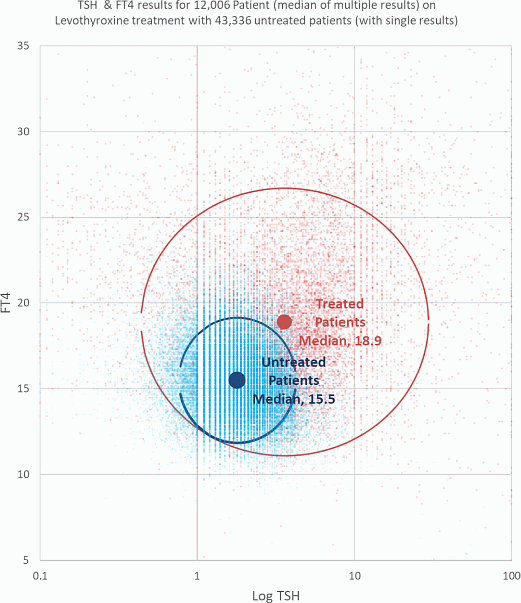ETA2024 Oral Presentations Oral Session 10: Thyroid dysfunction-2 (5 abstracts)
The relation between circulating free thyroxine (FT4) and thyroid stimulating hormone (TSH) levels is very different in people taking levothyroxine vs those who are on no thyroid hormone replacement
Adrian Heald 1 , Mike Stedman 2 , Onyebuchi Okosieme 3 , Lakdasa Premawardhana 4 , Colin Dayan 5 & Peter Taylor 6
1Salford Royal Hospital, Endocrinology, Salford, United Kingdom; 2Res Consortium, Andover, United Kingdom; 3Cardiff University, Prince Charles Hospital, Cardiff University School of Medicine, Cardiff, United Kingdom; 4Cardiff University School of Medicine, Division of Infection and Immunity, Thyroid Research Group, Cardiff, United Kingdom; 5Thyroid Research Group, School of Medicine, Cardiff University, Cardiff, United Kingdom; 6Cardiff University, School of Medicine, Cardiff University School of Medicine, Cardiff, United Kingdom
Introduction: There continues to be much discussion around optimization of thyroid hormone status in hypothyroid individuals. The ideal therapeutic goal in hypothyroidism would be to restore clinical and biochemical euthyroidism via physiologic thyroid hormone replacement. This concept may seem straightforward, but there are subtleties that have only recently been recognized. We here looked the way that FT4 and TSH related to each other in a large laboratory sample of people who underwent a check of thyroid function (TFT) split between those on levothyroxine replacement (monitoring test) and those who underwent a TFT check as a screening test for thyroid hormone imbalance (not on levothyroxine).
Methods: TFT test (FT4 and TSH) results were taken from the Salford Hospital (UK) laboratory system for 2009-2012. The request includes a tick box for ‘on levothyroxine’ (yes or no). Age and sex of patients was also available. To minimise comorbidity effects only samples taken in GP Practices were used and for untreated patients only those who had single tests results were used. For treated patients, the median value across all their results were used. Cluster analysis compared the log(TSH) and FT4 values between treated and untreated population to highlight the % of treated patients achieving levels similar to the untreated population. Analysis examined the impact of age and sex on this difference cluster boundaries calculated using 95% & 5% percentile value for both log TSH and linear FT4. This analysis was repeated for split by age (<60 & >=60) and sex male/female.
Results: Total data included 290,000 tests for 130,000 patients. However, the FT4/TSH results were used from 12,006 (F 9,231 / M 2,775 & (age <60 5,850 & age >=60 6,567)) treated patients with 43,846 actual test results. These were compared to the single results for 43,394 untreated patients (F 24,386 / M19,008 & Age<60 32,537 / Age>=60 10,857). Cluster analysis showed overall for untreated patients’ median values for TSH=1.8 mUnits/l and FT4=15.5 pmol/l, with 24% patients falling outside the 5%/95% limit, while for treated patients median TSH=3.6mUnits/l (+100% vs untreated) and FT4=18.9 pmol/l (+22%), with 22 % of treated patients falling outside the treated 5%/95% percentile boundary. When considered against the untreated boundary 75% of treated results fell outside; by sex females 78%, males 68%; by age <60 73%, >=60 74%.
Conclusion: The current treatment regimens being applied of either low or high dose levothyroxine are not delivering the expected laboratory TFT profiles, with significant numbers of treated patients being well outside the expected values - both TSH and FT4 being significantly higher. This effect seems to be more prevalent in women than men, which is more concerning given the higher number of women requiring treatment.





